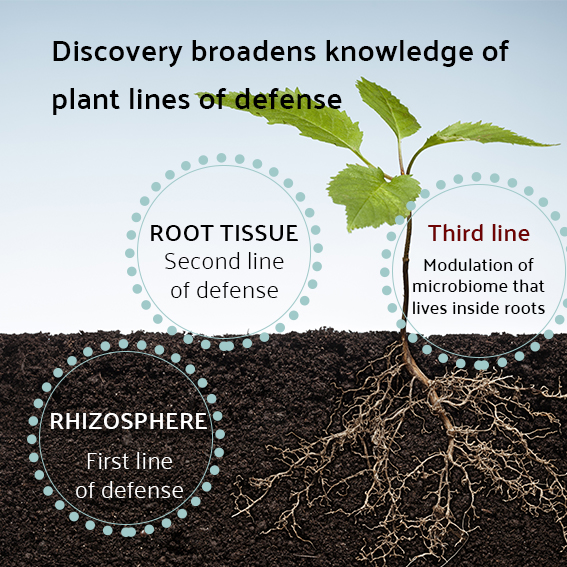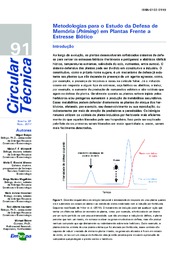Brazil participates in unprecedented discovery on plant defense mechanism
Brazil participates in unprecedented discovery on plant defense mechanism
Photo: iStock

Scientists discovered that microorganisms present in the roots work in mechanism of protection against diseases.
A group of scientists from Netherlands, Brazil, and the United States, with the participation of Embrapa Environment (Jaguariúna, SP), discovered that when the plants are attacked by pathogens in the roots, they are capable of interacting with soil fungi and bacteria to protect themselves from diseases in a broader and much more complex scale than previously known by science. Exploring such mechanisms opens possibilities for the control of diseases and agricultural pests, including the discovery of new molecules. Studies like that pave the way for a more sustainable agriculture, reducing the need for the use of chemicals to control diseases.
Published on Science magazine, the paper describes how the microbial flora that lives within roots defends the plants against the invasion of pathogens, an original discovery.
In 2011, the team had already published another paper in the same magazine, which described the way plants control the recruitment of beneficial bacteria in the rhizosphere, which is the soil area that is closest to the roots, and they use them to protect themselves from diseases.
The third line of defense
In the new work, the scientists wanted to expand the understanding of the complex interaction between plant and microbiome. With that purpose, they investigated the pathogens that reach inside the roots. To do that, the microorganismos have to cross the rhizosphere (the first line of defense) and the plant tissue (second line of defense). During the work, the researchers discovered a third line of defense against infection: a modulation of the microbiome that lives inside the roots.
The method of choice used a metagenomics and complex network inference approach to guide the elaboration of a consortium of Chitinophaga and Flavobacterium bacteria that was introduced in the roots to neutralize the disease. Then the group used the CRISPR technique to confirm that the NRPS-PKS gene cluster is responsible for the suppression of the disease inside the plant..
 In practice, the findings showed that endophytic root microbiomes harbor a variety of little known functional traits that, in concert, can protect the plant from the inside out.
In practice, the findings showed that endophytic root microbiomes harbor a variety of little known functional traits that, in concert, can protect the plant from the inside out.
The Embrapa researcher Rodrigo Mendes,one of the authors of the paper, reports that this study represents a landmark in research on plant microbiomes. “For a long time we have known the importance of endophytic microorganisms for the promotion of plant growth and health, but we still know very little about the genomics and functional diversity of endophytic microbiomes and their interaction with plants and pathogens. We followed the steps of the fungus after infecting the plant, dissected the process, and used advanced molecular techniques to elucidate the mechanisms that govern plant defense”, he explains.
The discovery of the defensive bacteria
The investigation focused on the functional potential of root microbiomes to protect plants against fungal infections. Using advanced techniques from different approaches (such as network inference and metagenomics), the scientists identified bacterial consortia found in soils that are unfavorable, i.e. suppressing the development of the Rhizoctonia solani fungus, which causes diseases in different plants like rice, wheat and sweet beetroot. The techniques were also used to identify functional gene clusters from microorganisms that inhabit such soils.
The scientists analyzed cultivated beetroot seedlings in soils suppressing R. solani to identify the microorganisms associated with disease suppression, hence characterizing biosynthetic gene clusters (BGCs). The following step was to reconstruct the synthetic consortium of endophytic microorganisms and, finally, guide the mutations to test the specific role of BGCs in the response to the disease.
The experiments showed that, under a pathogen invasion, bacteria of the Chitinophagaceae and Flavobacteriaceae genera were enriched in the plant endosphere and attacked the fungus. They showed enhanced enzymatic activities that provoked the degradation of the fungus' cell walls. The location of such two bacterial genera in root tissue and how they interact at molecular level in the endosphere is still unknown.
“The results of this study point to the richness of largely unknown microbial genera and their functional traits in endophytic root microbiomes, questions that stimulate the continuity and furthering of the studies”, declares Mendes.

Translation: Mariana Medeiros
Marcos Vicente (MTb 19.027/MG)
Embrapa Environment
Press inquiries
meio-ambiente.imprensa@embrapa.br
Phone number: +55 19 3311-2611
Further information on the topic
Citizen Attention Service (SAC)
www.embrapa.br/contact-us/sac/


